(劳动经济学)考试大纲
- 格式:doc
- 大小:21.38 KB
- 文档页数:4
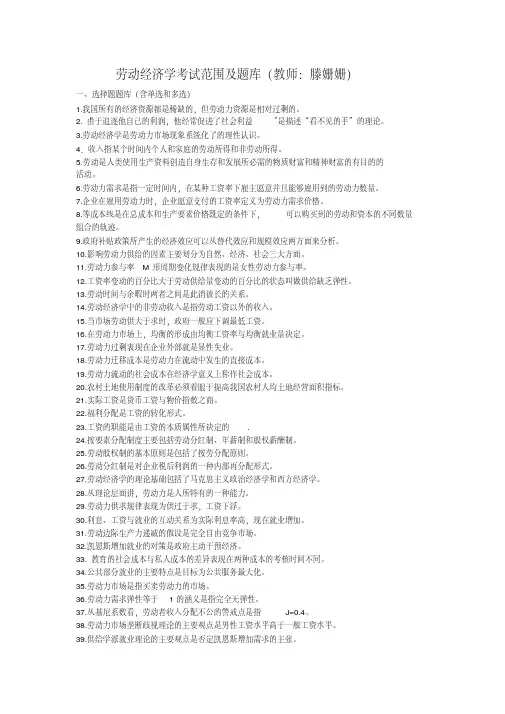
劳动经济学考试范围及题库(教师:滕姗姗)一、选择题题库(含单选和多选)1.我国所有的经济资源都是稀缺的,但劳动力资源是相对过剩的。
2.“由于追逐他自己的利润,他经常促进了社会利益”是描述“看不见的手”的理论。
3.劳动经济学是劳动力市场现象系统化了的理性认识。
4.收入指某个时间内个人和家庭的劳动所得和非劳动所得。
5.劳动是人类使用生产资料创造自身生存和发展所必需的物质财富和精神财富的有目的的活动。
6.劳动力需求是指一定时间内,在某种工资率下雇主愿意并且能够雇用到的劳动力数量。
7.企业在雇用劳动力时,企业愿意支付的工资率定义为劳动力需求价格。
8.等成本线是在总成本和生产要素价格既定的条件下,可以购买到的劳动和资本的不同数量组合的轨迹。
9.政府补贴政策所产生的经济效应可以从替代效应和规模效应两方面来分析。
10.影响劳动力供给的因素主要划分为自然、经济、社会三大方面。
11.劳动力参与率M形周期变化规律表现的是女性劳动力参与率。
12.工资率变动的百分比大于劳动供给量变动的百分比的状态叫做供给缺乏弹性。
13.劳动时间与余暇时两者之间是此消彼长的关系。
14.劳动经济学中的非劳动收入是指劳动工资以外的收入。
15.当市场劳动供大于求时,政府一般应下调最低工资。
16.在劳动力市场上,均衡的形成由均衡工资率与均衡就业量决定。
17.劳动力过剩表现在企业外部就是显性失业。
18.劳动力迁移成本是劳动力在流动中发生的直接成本。
19.劳动力流动的社会成本在经济学意义上称作社会成本。
20.农村土地使用制度的改革必须着眼于提高我国农村人均土地经营面积指标。
21.实际工资是货币工资与物价指数之商。
22.福利分配是工资的转化形式。
23.工资的职能是由工资的本质属性所决定的.24.按要素分配制度主要包括劳动分红制、年薪制和股权薪酬制。
25.劳动股权制的基本原则是包括了按劳分配原则。
26.劳动分红制是对企业税后利润的一种内部再分配形式。
27.劳动经济学的理论基础包括了马克思主义政治经济学和西方经济学。
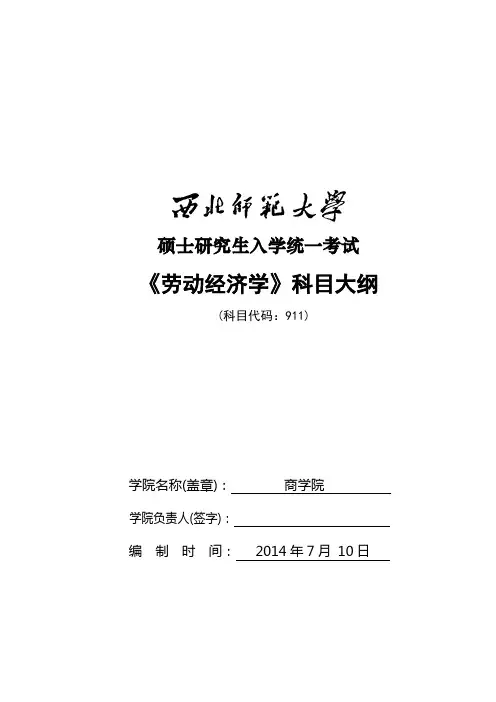
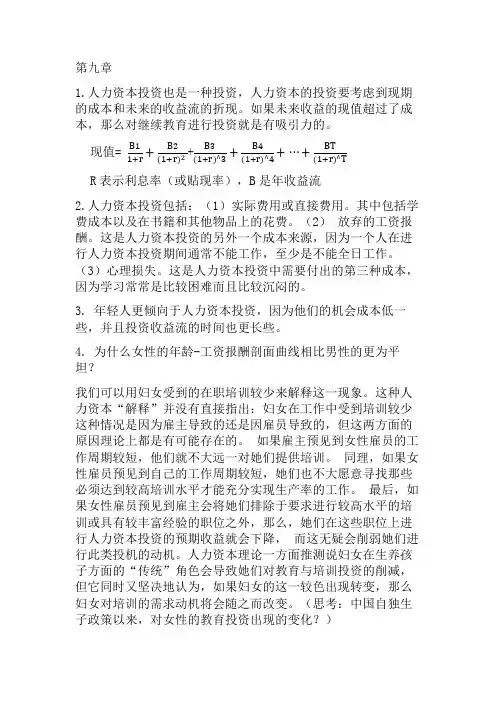
第九章1.人力资本投资也是一种投资,人力资本的投资要考虑到现期的成本和未来的收益流的折现。
如果未来收益的现值超过了成本,那么对继续教育进行投资就是有吸引力的。
现值= B11+r +B2(1+r)2+B3(1+r)^3+B4(1+r)^4+⋯+BT(1+r)^TR表示利息率(或贴现率),B是年收益流2.人力资本投资包括:(1)实际费用或直接费用。
其中包括学费成本以及在书籍和其他物品上的花费。
(2)放弃的工资报酬。
这是人力资本投资的另外一个成本来源,因为一个人在进行人力资本投资期间通常不能工作,至少是不能全日工作。
(3)心理损失。
这是人力资本投资中需要付出的第三种成本,因为学习常常是比较困难而且比较沉闷的。
3. 年轻人更倾向于人力资本投资,因为他们的机会成本低一些,并且投资收益流的时间也更长些。
4. 为什么女性的年龄-工资报酬剖面曲线相比男性的更为平坦?我们可以用妇女受到的在职培训较少来解释这一现象。
这种人力资本“解释”并没有直接指出:妇女在工作中受到培训较少这种情况是因为雇主导致的还是因雇员导致的,但这两方面的原因理论上都是有可能存在的。
如果雇主预见到女性雇员的工作周期较短,他们就不大远一对她们提供培训。
同理,如果女性雇员预见到自己的工作周期较短,她们也不大愿意寻找那些必须达到较高培训水平才能充分实现生产率的工作。
最后,如果女性雇员预见到雇主会将她们排除于要求进行较高水平的培训或具有较丰富经验的职位之外,那么,她们在这些职位上进行人力资本投资的预期收益就会下降,而这无疑会削弱她们进行此类投机的动机。
人力资本理论一方面推测说妇女在生养孩子方面的“传统”角色会导致她们对教育与培训投资的削减,但它同时又坚决地认为,如果妇女的这一较色出现转变,那么妇女对培训的需求动机将会随之而改变。
(思考:中国自独生子政策以来,对女性的教育投资出现的变化?)5. 在职培训的投资会减少实际的工资报酬,但是如果此人不再接受进一步培训,而且他或她从学校获得的知识和技能也不随着时间的延续而贬值,那么在他或她的整个生命周期中,工资报酬会保持不变。
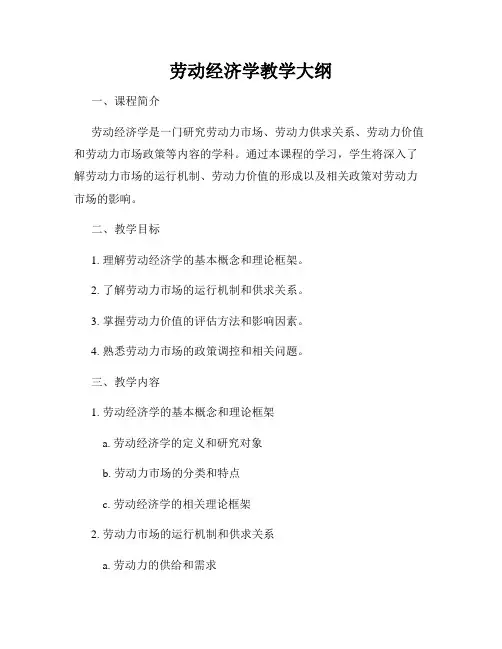
劳动经济学教学大纲一、课程简介劳动经济学是一门研究劳动力市场、劳动力供求关系、劳动力价值和劳动力市场政策等内容的学科。
通过本课程的学习,学生将深入了解劳动力市场的运行机制、劳动力价值的形成以及相关政策对劳动力市场的影响。
二、教学目标1. 理解劳动经济学的基本概念和理论框架。
2. 了解劳动力市场的运行机制和供求关系。
3. 掌握劳动力价值的评估方法和影响因素。
4. 熟悉劳动力市场的政策调控和相关问题。
三、教学内容1. 劳动经济学的基本概念和理论框架a. 劳动经济学的定义和研究对象b. 劳动力市场的分类和特点c. 劳动经济学的相关理论框架2. 劳动力市场的运行机制和供求关系a. 劳动力的供给和需求b. 工资决定的基本原理c. 劳动力市场的均衡与失衡3. 劳动力价值的评估方法和影响因素a. 劳动力价值的理论基础b. 劳动力价值评估方法的应用c. 影响劳动力价值的因素4. 劳动力市场的政策调控和相关问题a. 政府对劳动力市场的干预b. 劳动力市场的结构性失衡问题c. 劳动力市场的不平等与福利四、教学方法1. 授课方式:理论讲解与案例分析相结合。
2. 学生参与:鼓励学生提问和互动,引导学生思考和探索。
3. 实践活动:组织学生进行实地调研或实验设计,以加深对劳动力市场的理解。
五、教学评价方法1. 平时成绩:包括课堂参与、作业完成情况等。
2. 期中考核:进行理论知识的答题测试。
3. 期末考试:综合考察学生对劳动经济学的掌握和理解能力。
4. 课堂演讲:鼓励学生进行相关主题的课堂演讲,评价其表达和分析能力。
六、参考教材1. 《劳动经济学导论》(第三版),作者:John M. Keynes,出版社:人民出版社。
2. 《劳动力市场分析与劳动经济学》(第五版),作者:George J. Borjas,出版社:清华大学出版社。
七、教学进度安排1. 第一周:课程介绍和基本概念讲解2. 第二周:劳动力市场的分类和特点3. 第三周:供给和需求分析4. 第四周:工资决定的基本原理5. 第五周:劳动力市场的均衡与失衡6. 第六周:劳动力价值的评估方法与影响因素7. 第七周:政府对劳动力市场的干预8. 第八周:劳动力市场的结构性失衡问题9. 第九周:劳动力市场的不平等与福利10. 第十周:复习与总结八、教学资源1. 课程教材和参考书籍2. 课程PPT和讲义3. 相关案例和实地调研资料4. 论文和学术文章以上便是《劳动经济学教学大纲》的内容安排。
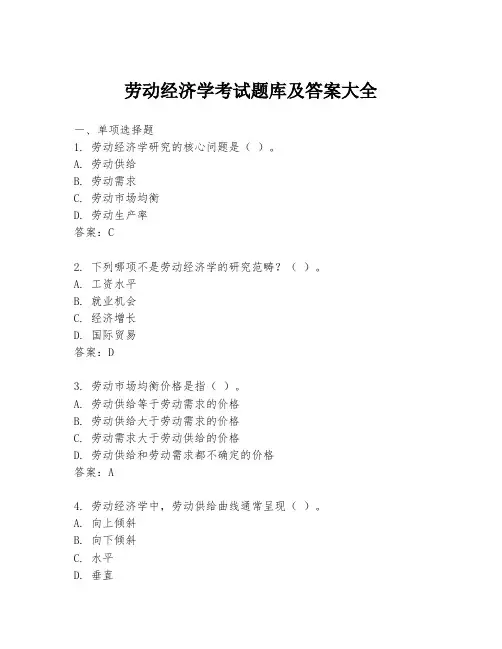
劳动经济学考试题库及答案大全一、单项选择题1. 劳动经济学研究的核心问题是()。
A. 劳动供给B. 劳动需求C. 劳动市场均衡D. 劳动生产率答案:C2. 下列哪项不是劳动经济学的研究范畴?()。
A. 工资水平B. 就业机会C. 经济增长D. 国际贸易答案:D3. 劳动市场均衡价格是指()。
A. 劳动供给等于劳动需求的价格B. 劳动供给大于劳动需求的价格C. 劳动需求大于劳动供给的价格D. 劳动供给和劳动需求都不确定的价格答案:A4. 劳动经济学中,劳动供给曲线通常呈现()。
A. 向上倾斜B. 向下倾斜C. 水平D. 垂直答案:A5. 劳动经济学中,劳动需求曲线通常呈现()。
A. 向上倾斜B. 向下倾斜C. 水平D. 垂直答案:B二、多项选择题1. 劳动经济学中的劳动供给曲线可能受到以下哪些因素的影响?()。
A. 工资率B. 人口增长率C. 工作时间长度D. 劳动生产率答案:ABC2. 劳动经济学中,影响劳动需求的因素包括()。
A. 产品价格B. 生产技术C. 劳动生产率D. 劳动成本答案:ABCD3. 劳动经济学中,劳动市场失衡可能表现为()。
A. 失业B. 通货膨胀C. 工资水平下降D. 劳动力短缺答案:AD三、判断题1. 劳动经济学中的劳动供给曲线是一条向下倾斜的曲线。
()答案:错误2. 劳动经济学中的劳动需求曲线是一条向上倾斜的曲线。
()答案:错误3. 劳动经济学研究的目的是提高劳动生产率。
()答案:错误4. 劳动经济学中的劳动市场均衡价格是劳动供给等于劳动需求的价格。
()答案:正确5. 劳动经济学中,劳动供给曲线和劳动需求曲线的交点决定了劳动市场的均衡工资和就业水平。
()答案:正确四、简答题1. 简述劳动经济学中劳动供给曲线的影响因素。
答案:劳动供给曲线的影响因素包括工资率、个人偏好、工作时间长度、教育水平、人口增长率、技术进步等。
2. 阐述劳动经济学中劳动需求曲线向下倾斜的原因。
答案:劳动需求曲线向下倾斜的原因主要是边际收益递减,即随着劳动投入的增加,每增加一个单位的劳动所带来的额外产出会逐渐减少,因此企业愿意支付的工资率也会随之下降。
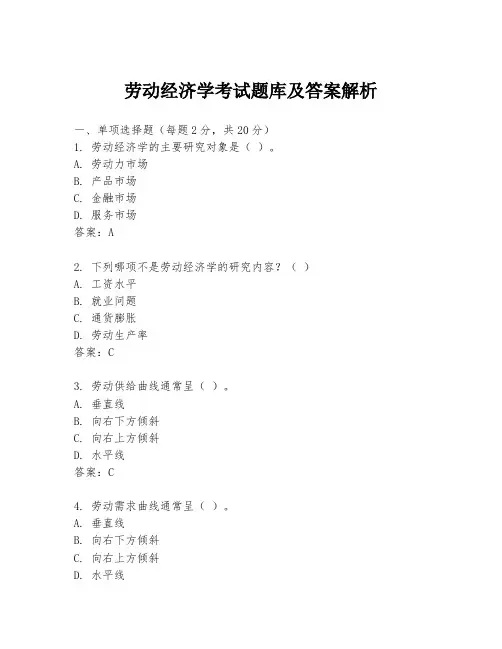
劳动经济学考试题库及答案解析一、单项选择题(每题2分,共20分)1. 劳动经济学的主要研究对象是()。
A. 劳动力市场B. 产品市场C. 金融市场D. 服务市场答案:A2. 下列哪项不是劳动经济学的研究内容?()A. 工资水平B. 就业问题C. 通货膨胀D. 劳动生产率答案:C3. 劳动供给曲线通常呈()。
A. 垂直线B. 向右下方倾斜C. 向右上方倾斜D. 水平线答案:C4. 劳动需求曲线通常呈()。
A. 垂直线B. 向右下方倾斜C. 向右上方倾斜D. 水平线答案:B5. 劳动经济学中的“边际生产力理论”是由哪位经济学家提出的?()A. 亚当·斯密B. 大卫·李嘉图C. 卡尔·马克思D. 阿尔弗雷德·马歇尔答案:D6. 劳动经济学中的“人力资本理论”是由哪位经济学家提出的?()A. 亚当·斯密B. 大卫·李嘉图C. 卡尔·马克思D. 贝克尔答案:D7. 劳动经济学中,劳动供给的替代效应是指()。
A. 工资上升导致工作小时数减少B. 工资上升导致工作小时数增加C. 工资下降导致工作小时数减少D. 工资下降导致工作小时数增加答案:A8. 劳动经济学中,劳动需求的替代效应是指()。
A. 工资上升导致劳动需求减少B. 工资上升导致劳动需求增加C. 工资下降导致劳动需求减少D. 工资下降导致劳动需求增加答案:A9. 劳动经济学中,劳动供给的互补效应是指()。
A. 工资上升导致工作小时数减少B. 工资上升导致工作小时数增加C. 工资下降导致工作小时数减少D. 工资下降导致工作小时数增加答案:B10. 劳动经济学中,劳动需求的互补效应是指()。
A. 工资上升导致劳动需求减少B. 工资上升导致劳动需求增加C. 工资下降导致劳动需求减少D. 工资下降导致劳动需求增加答案:B二、多项选择题(每题3分,共15分)1. 下列哪些因素会影响劳动供给?()A. 工资水平B. 人口数量C. 工作条件D. 教育水平答案:ABCD2. 劳动经济学中,哪些因素会影响劳动需求?()A. 工资水平B. 产品价格C. 技术进步D. 消费者偏好答案:ABCD3. 劳动经济学中,哪些因素会影响工资水平?()A. 劳动供给B. 劳动需求C. 工会力量D. 政府政策答案:ABCD4. 下列哪些理论属于劳动经济学的研究范畴?()A. 边际生产力理论B. 人力资本理论C. 劳动力市场分割理论D. 劳动供给与需求理论答案:ABCD5. 劳动经济学中,哪些因素会影响劳动生产率?()A. 教育水平B. 技术进步C. 工作条件D. 劳动时间答案:ABCD三、简答题(每题5分,共20分)1. 简述劳动经济学的研究范围。
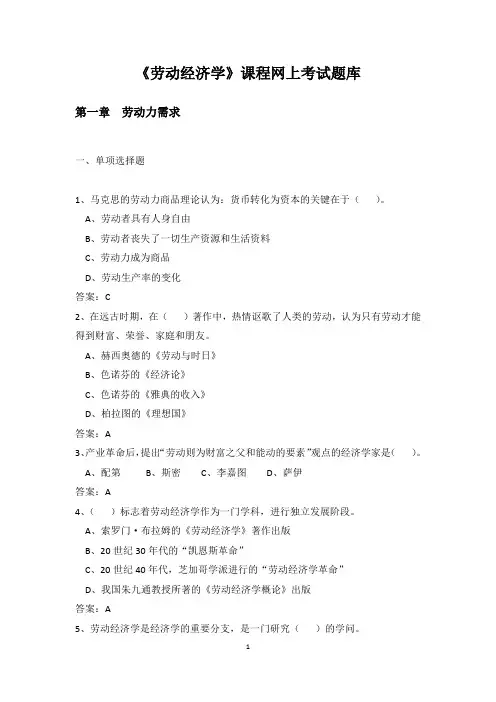
《劳动经济学》课程网上考试题库第一章劳动力需求一、单项选择题1、马克思的劳动力商品理论认为:货币转化为资本的关键在于()。
A、劳动者具有人身自由B、劳动者丧失了一切生产资源和生活资料C、劳动力成为商品D、劳动生产率的变化答案:C2、在远古时期,在()著作中,热情讴歌了人类的劳动,认为只有劳动才能得到财富、荣誉、家庭和朋友。
A、赫西奥德的《劳动与时日》B、色诺芬的《经济论》C、色诺芬的《雅典的收入》D、柏拉图的《理想国》答案:A3、产业革命后,提出“劳动则为财富之父和能动的要素”观点的经济学家是()。
A、配第B、斯密C、李嘉图D、萨伊答案:A4、()标志着劳动经济学作为一门学科,进行独立发展阶段。
A、索罗门·布拉姆的《劳动经济学》著作出版B、20世纪30年代的“凯恩斯革命”C、20世纪40年代,芝加哥学派进行的“劳动经济学革命”D、我国朱九通教授所著的《劳动经济学概论》出版答案:A5、劳动经济学是经济学的重要分支,是一门研究()的学问。
A、劳动生产率B、劳动的人C、劳动资料D、劳动要素答案:B6、劳动力是指()A、人的劳动能力B、具有劳动能力的人“人”C、简单的生理劳动D、劳动答案:A7、劳动需求曲线向左下方向移动,说明劳动力需求()A、增加B、减少C、不变D、难以判定答案:B8、在1960年,提出了人力资本投资理论是()A、贝克尔B、舒尔茨C、马歇尔D、马克思答案:B9、马克思的相对过剩人口理论认为,相对过剩人口的存在形式不包括()A、流动的过剩人口B、潜在的过剩人口C、停滞的过剩人口D、固定的过剩人口答案:D10、在劳动力市场动态均衡模型中,动态均衡无法达到的条件是()A、劳动力供给弹性大于劳动力需求弹性B、劳动力供给弹性小于劳动力需求弹性C、劳动力供给弹性等于劳动力需求弹性D、工资率的波动对劳动力供给量的影响越来越小答案:A9、动态均衡分析是指在考察市场均衡时,变量的调整()A、没有抽象掉时间因素B、抽象掉了时间因素C、不需要花时间完成D、在同一时间内完成答案:A二、多项选择题1、造成工资国民差异的原因()。
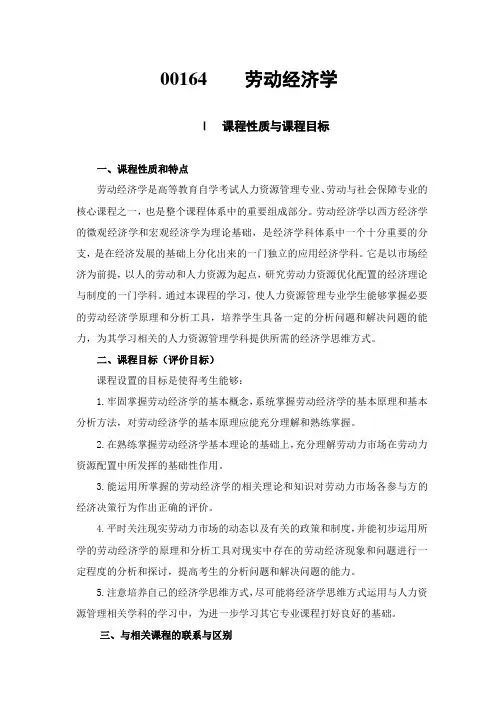
00164 劳动经济学Ⅰ课程性质与课程目标一、课程性质和特点劳动经济学是高等教育自学考试人力资源管理专业、劳动与社会保障专业的核心课程之一,也是整个课程体系中的重要组成部分。
劳动经济学以西方经济学的微观经济学和宏观经济学为理论基础,是经济学科体系中一个十分重要的分支,是在经济发展的基础上分化出来的一门独立的应用经济学科。
它是以市场经济为前提,以人的劳动和人力资源为起点,研究劳动力资源优化配置的经济理论与制度的一门学科。
通过本课程的学习,使人力资源管理专业学生能够掌握必要的劳动经济学原理和分析工具,培养学生具备一定的分析问题和解决问题的能力,为其学习相关的人力资源管理学科提供所需的经济学思维方式。
二、课程目标(评价目标)课程设置的目标是使得考生能够:1.牢固掌握劳动经济学的基本概念,系统掌握劳动经济学的基本原理和基本分析方法,对劳动经济学的基本原理应能充分理解和熟练掌握。
2.在熟练掌握劳动经济学基本理论的基础上,充分理解劳动力市场在劳动力资源配置中所发挥的基础性作用。
3.能运用所掌握的劳动经济学的相关理论和知识对劳动力市场各参与方的经济决策行为作出正确的评价。
4.平时关注现实劳动力市场的动态以及有关的政策和制度,并能初步运用所学的劳动经济学的原理和分析工具对现实中存在的劳动经济现象和问题进行一定程度的分析和探讨,提高考生的分析问题和解决问题的能力。
5.注意培养自己的经济学思维方式,尽可能将经济学思维方式运用与人力资源管理相关学科的学习中,为进一步学习其它专业课程打好良好的基础。
三、与相关课程的联系与区别劳动经济学是经济学科体系中的一个重要的分支。
它以劳动力为考察对象,是研究劳动力市场的运行及其结果的一门应用经济学学科。
劳动经济学作为一门应用经济学是以西方理论经济学的基本原理为其学科的基础,因此学习劳动经济学必须首先学习和掌握西方经济学的微观经济学和宏观经济学的相关理论;同时劳动经济学在研究问题时常采用数学和统计方法作为其分析工具,因此要学好劳动经济学还应学习和掌握必要的高等数学和统计性知识。
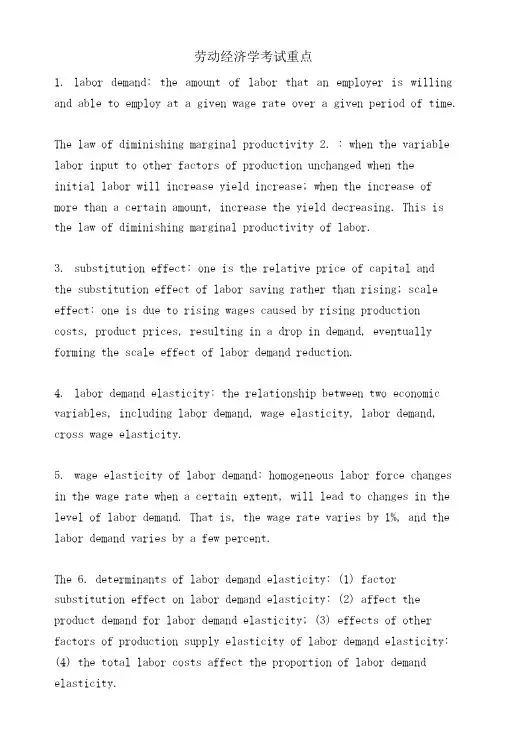
劳动经济学考试重点1. labor demand: the amount of labor that an employer is willing and able to employ at a given wage rate over a given period of time.The law of diminishing marginal productivity 2. : when the variable labor input to other factors of production unchanged when theinitial labor will increase yield increase; when the increase of more than a certain amount, increase the yield decreasing. This is the law of diminishing marginal productivity of labor.3.substitution effect: one is the relative price of capital andthe substitution effect of labor saving rather than rising; scale effect: one is due to rising wages caused by rising production costs, product prices, resulting in a drop in demand, eventually forming the scale effect of labor demand reduction.bor demand elasticity: the relationship between two economic variables, including labor demand, wage elasticity, labor demand, cross wage elasticity.5.wage elasticity of labor demand: homogeneous labor force changes in the wage rate when a certain extent, will lead to changes in the level of labor demand. That is, the wage rate varies by 1%, and the labor demand varies by a few percent.The 6. determinants of labor demand elasticity: (1) factor substitution effect on labor demand elasticity: (2) affect the product demand for labor demand elasticity; (3) effects of other factors of production supply elasticity of labor demand elasticity: (4) the total labor costs affect the proportion of labor demand elasticity.7.- Hicks Marshall derived demand four rules: when other factors remain unchanged, (1) in the production function, between labor and other factors of production to replace the larger; (2) the greater the demand elasticity of products; (3) the supply elasticity of other production factors is larger;(4) labor the cost in the total cost of production with a greater proportion of the total labor demand elasticity, the greater the.8.no difference curve features: (1) there are a lot ofindifference curves on the same plane with an indifference curve representing all points on the curve between the utility of the same, different indifference curves of different utility; (2) inthe same plane, any two disjoint (no difference curve;3) no difference curve is a negative slope, convex curve; (4) the preferences of different, the shape of the indifference curve of different.The 9. is to consider the partial equilibrium analysis: single market and single relationship between commodity prices and supply and demand analysis method used in economics; partial equilibrium is assumed in other market factors in the static condition, and old on the single market equilibrium balance changes.General equilibrium analysis: an analysis method of price and supply and demand changes to all markets, study the market all goods in economics; the object of general equilibrium is established and dynamic equilibrium in the influence of various market factors under a market.The dynamic equilibrium of 10. labor market: three basic assumptions: (1) assume that the formation of labor supplydecisions for the period of time, as indicated by T; (2) assumethat labor demand during the period t decided this period wage rate; wage rate Wt and the period of labor demand for the period Dt, Wt=f (Dt) ; (3) assume that this t issue wage rate Wt under the current labor supply of St+1, St+1二f (Wt).The three model 11. labor market dynamic equilibrium: (1) the labor supply elasticity is less than the labor demand elasticity, the graph is called cobweb: therefore the labor supply elasticity isless than the labor demand elasticity is called the "cobweb stable condition”. (2) the elasticity of labor supply is greater than the elasticity of labor demand, which is called ''divergent cobweb"". (3) the elasticity of labor supply is equal to the elasticity oflab or demand, which is called "closed cobweb"”.12., the internal labor market: the level of labor market wages, treatment and other good; two labor market is relatively poor.bor time: also known as working hours, refers to the workers engaged in social work paid for the time spent.14.characteristics of labor time: (1) working hours prescribed by law;(2) the time when the worker performs the work obligations and the labor remuneration paid by the employing unit; (3) the sum of the time spent in the actual work time and the related activities.15.hourly wage: the form of wages paid according to the employee,s wage standard (labor price per unit time) and length of work. Scope of application: (1) the product quantity standard is difficult to determine precisely, it is difficult to measure the number ofproducts (services) of the industry and occupation; (2) mechanization, high degree of automation, working speed and labor results are determined by the individual, but mainly depends on the mechanical properties of the products of industry and enterprise; (3) product quantity over quality, strict quality requirements and the requirements of individual employees and high quality products manufacturing industry; (4) products, project management and production conditions and to facilitate the supervision and control of enterprise and etc..16.piece wage: it is a form of wage payment based on the number of workers, qualified products (work volume) and the rate of piecework wages. Scope of application: (1) the quantity and quality of product can accurately calculate the test, and can reflect the amount of labor workers in the production industry and enterprise;(2) the quantity and quality of products mainly depends on the workers of the hard work and effort; (3) product variety is relatively simple and the mass production industries andenterprises etc..17.wage negotiations: refers to under the condition of market economy, the enterprise, the employer or his organization is a party, to employees or trade unions for the other party, in the guidance and coordination of the government, to negotiate the enterprise wage distribution system.18.is the cause of wage difference: (1) industry (enterprise) between the wage gap; the skilled labor in proportion to the sizeof the industry; location; the industrial technological and economic characteristics affect the wage level: the degree of unionization and labour forces: the labor force supply and demand.(2) the wage differences between occupation; labor disutility of compensating differentials (i. e. some occupation labor environment, to bring spiritual loss, loss of health workers, such as "caused by the negative effects of labor" and 〃non monetary losses" need compensation in wages) ; the risk of compensating differentials (change difference stable type, occupation income difference) (i.e. some occupation wage is relatively stable, and some big changes; some occupation is stable, some are unstable and unemploymentrisk) ; human capital compensatory difference (i. e. laborer of the cost of education investment, wages should return the required); different occupation skill cost of different people, the internal rate of return. (3) individual workers wage differences; the competitive salary difference (wage difference or differences inthe quality of labor skills) : the monopoly of the wage gap (due to the special quality of workers or special level). (4) the wage differentials between areas of intra regional trade, capital flows and labor mobility (5) between the ages of human capital theory,the wage gap with the increase of age, level of education, knowledge and experience are accumulated, and the relationship between enterprise and deepening, by employers trust, because of their workers the reason and the employer, so with the increasing age of the seniority wage. (6) gender wage differentials between women despise the traditional concept, promotion and training opportunities for women is less than men, resulting in some women, not reuse, decreased enthusiasm; due to the less educated and low capacity, so the average wages of women less than men; the reasonof physiological and psychological nature. The women in the ranksof high-income workers have limited the opportunities of.19.: Lorenz curve to describe the distribution of social income differences, American statistician M Lorenz, this paper proposes amethod for judging the degree of equal distribution. The horizontal axis represents the accumulative number of households, the vertical axis represents the cumulative percentage of income, when the cumulant changes, can be drawn from the origin (0, 0) vertical axis (1, 1) of a downward curve, the Lorenz curve.20.: Lorenz curve and Gini coefficient absolute equality curve Wai area a,The area bounded by the absolute inequality curve is B, and then the quotient of the distribution can be expressed by the quotient of a divided by (a+b). This value is called Gini coefficient.21.Zaire market law theory: (1) under normal circumstances, relyon the price mechanism, the national internal economic imbalancewill quickly be eliminated by the commodity market and factormarket prices to exercise; (2) under normal circumstances, the market economy will automatically realize full employment, the deviation from the equilibrium is temporary phenomenon that is not normal, so unemployment is not inherent; (3) Zaire law against government intervention in the economy, the market economyadvocates laissez-faire.22.Keynes,s employment theory:Employment view: (1) think of involuntary unemployment; (2) non voluntary unemployment can not be solved by reducing monetary wages;(3) the cause of involuntary unemployment lies in the insufficient effective demand of society.Solution: (1) abandon laissez-faire policy, expand the functions ofthe government, a series of measures taken by the government intervention and regulation of the economy, the private monopoly capitalism to state monopoly capitalism; (2) to give up theprinciple of saving, encourage consumption; (3) should be taken to increase investment and stimulate consumption demand and improvethe method of the work, in the case of consumption given the level of investment, should be mainly carried out by the national socialization, overall investment; (4) the increase in government spending, debt, fiscal deficit and moderate inflation policy to stimulate the economy, increase effective demand, deal with the economic crisis, to achieve and maintain full employment.23.petty - Clark theorem: British economist Colin Clark William Petty on the basis of in-depth analysis of the employmentpopulation in the trend of the distribution structure of three industries after the evolution rules about the relationship between industrial structure and labor distribution. (1) with the development of economy and the improvement of national income,labor force from the first industry to the second industry; (2) when the level of per capita income further increases, the labor force will by second industry to the third industry of mobile.24.,frictional unemployment: because of the time difference between the requirement for employment and the obtaining of jobs.25. seasonal unemployment is caused by seasonal production or changes in the market, resulting in seasonal fluctuations in labor demand, resulting in the loss of workers' jobs.26.,frictional unemployment, seasonal unemployment and structural unemployment can not be avoided.27. human capital: a form of capital corresponding to physical capital, which represents the ability and knowledge to bring permanent economic income to any individual.28.,the characteristics of human capital: (1) human capital is a productive ability that is attached to laborers; (2) the ownership of human capital does not have the property of transfer or inheritance.29. human capital investment: the labor force quality structure, such as knowledge, skills, physical and mental health of the human capital entity, that is conducive to the formation and quality of labor cost and time structure, is the human capital investment behavior. In addition, the behavior, cost and time which are beneficial to improving the utilization rate of human capital also belong to the category of human capital investment.30.,the main forms of human capital investment are: (1) formal education at all levels; (2) vocational training techniques; (3) health care; (4) the flow of people from one region to another.31.characteristics of human capital investment: (1) extensive investment income; (2) delayed and long-term investment returns obtained; (3) many aspects of investment income.32.general training: refers to employees through training for business and technical knowledge, skills, except for its subordinate enterprise organization is also applicable, which accept the general staff can take to other enterprises and get a job, and the current skills commensurate with the higher wage rate.33.,special training: refers to the training of business knowledge and skills acquired by employees, only for training enterprises have applicability,Or it can make training firms more productive than other companies, which are only good for companies that offer training.34.conditions: labor mobility between the individual ownership of the labor force in different regions and there exist differences between economic benefits and social employment to give full autonomy to the social division of labor specialization caused by labor skills and work ability35.the factors affecting labor mobility: (1) age (2) family education (3) (4) flow distance (5) unemployment rate (6) occupation permit system (7) national and local policies will influence the labor mobility (8) International Union (9) (10) into the environment quality and climate36.discrimination: labor market discrimination refers to those who have the same ability, education, training and experience and the final show of laborers in the same productivity, due to some non economic individual characteristics caused by employment, occupation selection, promotion, salary, training and other aspects to accept unfair treatment by the.37., the types of discrimination: (1) wage discrimination; (2) employment discrimination; (3) Occupational Discrimination;(4) human capital investment discrimination.38.fiscal policy: refers to the government to use the budget toadjust the overall demand level, in order to promote full employment, stabilize prices and economic growth of a macroeconomic management countermeasures. Fiscal policy includes regulating the economy by increasing the level of government revenues and budget expenditures.39.monetary policy: refers to the government to control the money supply as a means, through interest rates to adjust the level of aggregate demand, in order to promote full employment, stabilize prices and economic growth of a macroeconomic management countermeasures. Monetary policy also includes two kinds: expansionary monetary policy and tight monetary policy.40.specific measures of human policy: (1) increase the investment of human capital: (2) strengthen occupation guidance and occupation;(3) employment incentive measures; (4) the implementation of employment plan; (5) the development of temporary jobs.。
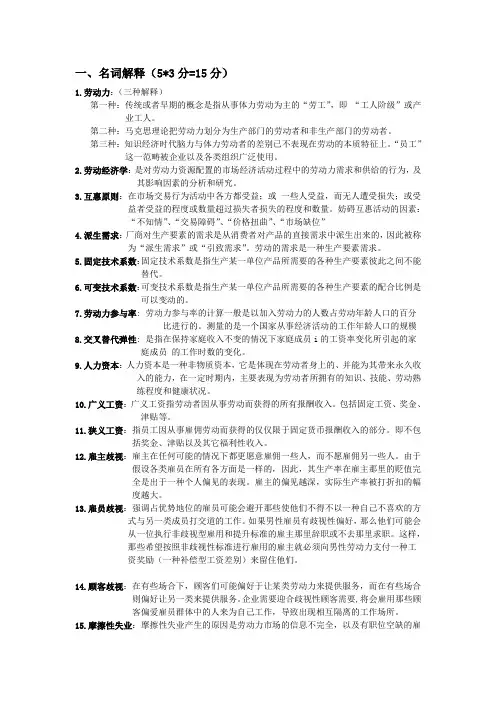
一、名词解释(5*3分=15分)1.劳动力:(三种解释)第一种:传统或者早期的概念是指从事体力劳动为主的“劳工”,即“工人阶级”或产业工人。
第二种:马克思理论把劳动力划分为生产部门的劳动者和非生产部门的劳动者。
第三种:知识经济时代脑力与体力劳动者的差别已不表现在劳动的本质特征上。
“员工”这一范畴被企业以及各类组织广泛使用。
2.劳动经济学:是对劳动力资源配置的市场经济活动过程中的劳动力需求和供给的行为,及其影响因素的分析和研究。
3.互惠原则:在市场交易行为活动中各方都受益;或一些人受益,而无人遭受损失;或受益者受益的程度或数量超过损失者损失的程度和数量。
妨碍互惠活动的因素:“不知情”、“交易障碍”、“价格扭曲”、“市场缺位”4.派生需求:厂商对生产要素的需求是从消费者对产品的直接需求中派生出来的,因此被称为“派生需求”或“引致需求”。
劳动的需求是一种生产要素需求。
5.固定技术系数:固定技术系数是指生产某一单位产品所需要的各种生产要素彼此之间不能替代。
6.可变技术系数:可变技术系数是指生产某一单位产品所需要的各种生产要素的配合比例是可以变动的。
7.劳动力参与率:劳动力参与率的计算一般是以加入劳动力的人数占劳动年龄人口的百分比进行的。
测量的是一个国家从事经济活动的工作年龄人口的规模8.交叉替代弹性: 是指在保持家庭收入不变的情况下家庭成员i的工资率变化所引起的家庭成员的工作时数的变化。
9.人力资本:人力资本是一种非物质资本,它是体现在劳动者身上的、并能为其带来永久收入的能力,在一定时期内,主要表现为劳动者所拥有的知识、技能、劳动熟练程度和健康状况。
10.广义工资:广义工资指劳动者因从事劳动而获得的所有报酬收入。
包括固定工资、奖金、津贴等。
11.狭义工资:指员工因从事雇佣劳动而获得的仅仅限于固定货币报酬收入的部分。
即不包括奖金、津贴以及其它福利性收入。
12.雇主歧视:雇主在任何可能的情况下都更愿意雇佣一些人,而不愿雇佣另一些人。
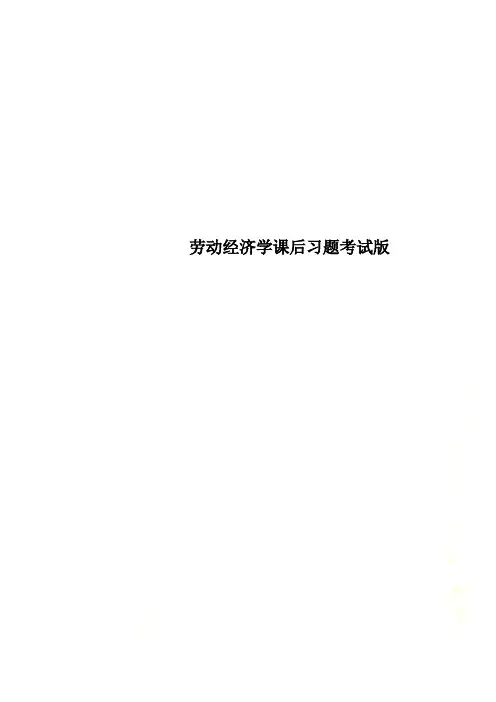
劳动经济学课后习题考试版第一章1.谈谈你对劳动经济学研究表述的理解:劳动经济学的研究对象:第一:在效用最大化假设下,劳动力资源的投入产出机理。
第二:劳动经济学研究劳动力市场的运行和结果。
第三:劳动经济学是对劳动力资源配置的市场经济活动过程中的劳动力需求和供给的行为及其影响因素的分析和研究。
劳动经济学研究方法:第一:实证经济学分析方法:在一定的假设前提下,人们的行为是怎样的。
两个假设前提:稀缺性;理性第二:规范经济学研究方法:用一定的价值观去衡量经济效益的好坏和制度政策的利弊,分析经济行为人的选择该是什么的问题劳动经济学的研究特点:第一:将问题的注意力投向了人们的工作范围第二:研究劳动经济问题的时候,不能脱离商品市场和资本市场来孤立的进行劳动经济的分析和研究。
2.举例说明运用实证经济学或规范经济学研究现实劳动经济或者人力资源管理问题的价值。
实证经济学:是真经济学实际上是一种对人的经济行为进行研究和分析的一种理论,它建立在两个假说之上,既稀缺性和人是有理性的。
从稀缺性方面来讲,正是由于稀缺性的存在,才产生了经济学上“机会成本”的概念。
它隐含的一个重要命题是人们对资源的使用存在着供求问题,存在着成本,特别是机会成本的问题。
所以,劳动力资源也是稀缺的,而这种稀缺的程度可以通过劳动力的价格-工资反映出来。
比如每年应届大学生的求职,在多种职业只能有一种选择。
而用人单位也只能在李四或者王五之间作出唯一的聘用选择。
从人是有理性的方面来说,个人追求效用的最大化,作为理性人的企业假设,即企业追求利润的最大化,所以在劳动力市场上雇主总希望以最低的成本来雇佣劳动力,以求最大利润,而对于个人来讲,作为雇员则希望找到一个工作条件舒适,报酬较高的工作。
规范经济学:从本质上讲,它的根本价值尺度是以互惠原则作为基础的出发点,互惠原则有三点:第一:市场交易活动所涉及的各方均受益,无人受到损失。
例如:企业高薪聘用经验丰富,能力足够强的外籍主管,对企业方来说此人将给企业带来相当大的价值,对个人来说将获取丰厚的回报。
高纲1245江苏省高等教育自学考试大纲00164劳动经济学南京师范大学编江苏省高等教育自学考试委员会办公室第一章导论【考核要求】一、劳动经济学的产生识记:古希腊和古罗马时期的劳动经济思想的主要内容欧洲中世纪的劳动经济思想的主要内容重商主义的劳动经济思想的主要内容领会:劳动经济学各学派的主要观点二、劳动经济学的研究对象与地位识记:劳动经济学的定义劳动经济学的研究对象劳动经济学在管理科学中的基础地位领会:劳动经济学与管理学、经济学、社会学的关系如何理解劳动经济学中的“稀缺性”三、劳动经济学的体系与研究方法识记:劳动经济学体系所含内容研究劳动经济学的一般方法和具体方法劳动力市场的含义四、劳动经济学的新发展识记:新古典学派的劳动经济理论的发展阶段制度学派的劳动经济理论的发展阶段领会:劳动经济学的若干前沿问题我国目前较为的劳动经济问题第二章劳动力供给【考核要求】一、劳动力供给概述识记:现代劳动经济学所研究的劳动力的含义劳动力供给的含义劳动参与率的含义劳动力供给的类型领会:劳动力资源的含义劳动参与率的主要影响因素应用:劳动力供给的主要形式及其影响供给的因素二、个人劳动力供给的基本模式识记:劳动时间分配的无差异曲线边际替代率个人劳动供给曲线领会:效用的特点应用:收入效应和替代效应对个人劳动力供给的影响三、家庭劳动力供给识记:家庭生产理论的基本内容劳动参与率的生命周期的含义领会:影响家庭劳动参与率变化的因素经济周期变动对劳动参与率的影响第三章劳动力需求【考核要求】一、劳动力需求的基本概念识记:劳动力需求的含义劳动力需求的自身工资弹性的含义劳动力需求的交叉工资弹性的含义影响劳动力需求的主要因素领会:影响劳动力需求弹性的因素二、企业劳动力需求的决定识记:企业短期劳动力需求原则企业长期劳动力需求的决定原则劳动力边际收益劳动力边际成本领会:固定技术系数条件下劳动需求的决定要素价格可变情况下的劳动需求决定三、劳动力市场均衡领会:劳动力市场的静态均衡劳动力市场的动态均衡第四章劳动力市场【考核要求】一、劳动力市场的一般理论识记:劳动力市场的含义劳动力市场的类型劳动力市场的影响因素内部劳动力市场的含义领会:劳动力市场的特征劳动力市场的功能二、劳动力资源的市场配置识记:职业的含义劳动交易的内容劳动力资源市场配置的原则领会:劳动力资源市场配置的机制三、政府行为与劳动力市场识记:国际劳工组织和我国有关最低工资的规定劳动力市场运行的制度建设应考虑的因素领会:政府在劳动力市场中的作用最低工资制对劳动力市场的影响第五章劳动力流动【考核要求】一、劳动力流动与劳动力流动的主要模型识记:劳动力流动的概念劳动力流动的条件劳动力流动的一般规律领会:劳动力流动理论的主要模型和内容二、劳动力流动的类型与决定因素识记:劳动力流动的类型领会:影响劳动力流动的决定性因素与其他因素三、劳动力的区域流动国际间劳动力流动的影响农村劳动力流动的影响国际人力资本流动的现状与趋势领会:农村劳动力转移的利弊和影响应用:评价发展中国家的人力资本流失第六章人力资本投资【考核要求】识记:人力资本的定义物质资本的定义人口质量投资对经济发展的作用二、人力资本投资的渠道识记:人力资本投资的形式人力资本投资的核算方法四、人力资本投资的比较分析识记:教育成本教育收益在职培训的定义领会:教育投资的成本和收益分析在职培训的成本和收益分析应用:教育成本与收益的计算(舒尔茨)五、人力资本理论的政策意义识记:人力资本理论的政策意义第七章劳动工资与福利【考核要求】一、主要工资理论的内容识记:早期工资理论的主要观点领会:克拉克的边际生产力工资理论应用:马歇尔的均衡工资理论二、工资与工资形式识记:狭义的工资广义的工资领会:工资与奖金、福利、津贴、补贴的不同三、工资水平识记:工资水平的衡量标准领会:影响工资水平的因素四、工资差别识记:地区之间的工资差别年龄之间的工资差别领会:产业工资差别职业间工资差别五、最低工资识记:最低工资的含义领会:最低工资标准的测量方法六、职业福利识记:职业福利的含义职业福利的作用职业福利的类型领会:职业福利的特征应用:实施职业福利的原则第八章工会【考核要求】一、工会的含义与功能识记;工会的含义工会的功能领会:工会的正面效应与负面效应二、工会结构和类型识记:工会的结构领会:工会的分类三、集体谈判的主要内容识记:集体谈判的定义集体谈判的程序集体谈判的种类领会:集体谈判的特点与功能集体谈判的结构四、中国工会识记:中国工会的性质中国工会的主要职能中国工会会员的募集方式中国工会机构的设置领会:新时期中国工会发展面临的新挑战应用:中国工会的创新第九章劳动保障【考核要求】一、劳动保障是社会保障的核心内容识记:社会保障的含义社会保障的特点我国的劳动保险项目领会:养老保险资金的来源医疗保险的特点失业保险的特点应用:劳动保险是社会保障制度的核心二、劳动保护的主要措施识记:劳动保护的含义领会:劳动保护的意义应用:加强安全生产管理的主要措施加强安全生产检查三、我国劳动保障制度识记:我国劳动保障改革的基本思路领会:政府在劳动保障制度中的作用第十章劳动就业【考核要求】一、就业理论的内容识记:劳动就业的概念充分就业的概念凯恩斯就业理论的内容货币学派和供给学派的就业理论的内容领会:不同就业理论的共性和特征二、影响劳动就业的因素识记:影响劳动就业的主要因素领会:人口因素对就业的影响经济因素对就业的影响应用:劳动制度因素对就业的影响三、我国城镇就业制度识记:就业制度的含义领会:我国城镇就业制度的改革第十一章失业【考核要求】一、失业的类型与原因识记:失业的概念失业的主要类型领会:各种失业的具体原因应用:摩擦性失业与劳动力市场的关系二、失业的衡量及社会承受力识记:失业率隐性失业的主要测量方法领会:失业的影响决定失业的社会承受力的因素应用:失业的衡量三、失业与通货膨胀的关系识记:工资膨胀率自然失业率的概念菲利普斯曲线领会:造成自然失业率上升的原因失业率与自然失业率的关系四、降低失业率的政策识记:主动的失业治理政策的主要内容被动的失业治理政策的主要内容领会:西方经济学家提出的失业治理的良策中国失业者的结构分析我国的失业的原因分析应用:解决我国失业问题的对策第十二章劳动管理【考核要求】一、政府管理与西方发达国家管理劳动力市场的经验识记:西方国家人力政策的目标和具体做法领会:西方国家对劳动力市场运行的调节干预的主要内容应用:我国政府对劳动力市场的宏观调控我国劳动管理体制的改革二、劳动法规的主要内容识记:劳动法的概念劳动合同的概念劳动关系的基本内容我国劳动就业管理制度领会:劳动合同的原则我国劳动争议的新特征应用:处理劳动争议的方法附录题型举例一、单选题:1、劳动力需求弹性包括劳动力需求的自身工资弹性和劳动力()A需求的交叉工资弹性B供给的自身弹性C 供给的交叉弹性D 供给单位弹性2、甲雇员的闲暇偏好大于乙雇员的闲暇偏好,则两者的等效用曲线的斜率关系为()A 甲大于乙B 甲小于乙C 两者相等D 无法判断二、多选题1、按照现代经济学、管理学和社会学对资本的认识,资本从形态上可以划分为()A物质资本B人力资本C金融资本D技术资本 E 社会资本2、工资形式包括()A 基本工资B 奖金C 津贴D 补贴E 计件工资三、辨析题1、市场劳动供给曲线是将一个市场中的个人劳动供给曲线相加。
劳动经济学第一章1.劳动力:一个人的身体即活的人体中存在的、每当他产生某种使用价值时就运用的体力和智力的总和。
2.劳动力资源:指能够从事各类工作的劳动力的人口,它是劳动力人口的数量和其平均质量的乘积。
3.劳动力需求:指一定时期内,在某种工资率下雇主愿意并能够雇用到的劳动力数量。
4.长期与短期劳动力需求长期:指企业的一切生产要素,无论资本、技术还是劳动力要素都是可变的,即任何条件都可能变化。
短期:指资本存量不变,唯一可变的因素是劳动投入量,即把在资本投入量不会变化,技术条件也不变的条件下对劳动力的需求称为短期需求。
5.劳动力需求、供给曲线(图1-1)图1-1劳动力需求曲线说明在其他条件不变的情况下,劳动力需求量与工资率之间的反向联系。
6.在市场经济条件下,大多数企业的基本目标是利润最大化。
π=R-C=QP-(Lw+Kr) 7.边际生产力递减规律(图4-2):在短期定义中,生产的其他要素固定不变,唯一可变的生产要素是劳动投入。
当把可变的劳动投入增加到不变的其他生产要素上时,最初劳动的增加会使产量增加;当其增加超过一定限度时,增加的产量开始递减。
(都先增后减/AP 与MP 的交点是AP 的最大值/MP=0,总产量最大)8.假设企业的产量X 增加,价格P 不变(完全竞争),SD总收入与总成本曲线(盈亏平衡点)9.单个企业的产量决定:当边际收入MR=MC边际成本时,产量X*,获得最大利润10.在完全竞争的劳动力市场中,边际收入=产品的边际生产力*产品价格11.完全竞争的劳动力市场的边际成本:边际成本=工资12.整个市场的劳动力需求函数L*W=L1W1+L2W2+…13.在长期劳动需求中,资本成为可变的生产要素14.等产量曲线:表明不同的生产技术和方法,资本和劳动投入的不同组合,其产量相等。
15.替代效应和规模效应替代效应:与资本的相对价格比上升而产生节约劳动力的效应。
(w↑,等产,劳动L1-L2被资本K2-K1取代,等产量曲线曲率越小,替代的可能性加大)规模效应:因工资上升造成生产成本上升,(供给曲线左上移动)引起产品价格上涨,导致产品需求下降,最终形成劳动力需求减少的效应。
本科劳动经济学课程试卷库及参考答案试卷一一.选择题(每题1分,共15分)1.引起劳动力需求量变动的根本原因是()A.工资率 B.生产技术 C.货币资本规模 D.企业的性质2.如果某种劳动力供给弹性系数大于1,则该劳动力供给弹性为()A.无限弹性 B.单位弹性 C.缺乏弹性 D.富有弹性3.计件工资的适用范围是()A.机械化、自动化程度高的行业和企业B.产品数量和质量不易准确确定的行业和企业C.产品数量和质量能准确计算检验的行业和企业D.产品、经营项目较多和生产条件多变的行业和企业4.在完全竞争市场下,企业短期利润最大化的条件表述错误的是()A. MRL =MCLB. MRP=MCLC. MPL=W /P D. MRP= W /P5.下列关于由劳动要素增加所引起的总产量TP.平均产量AP.边际产量MP及其相互关系说法错误的是()A. TP.AP.MP三条曲线都是先增后减B.当AP与MP相交时,TP达到最大值C.当 MP达到最大值时,TP曲线出现拐点D. AP与MP相交后,AP大于MP6.造成劳动力市场均衡工资率上升的因素有( )A.劳动力供给曲线左移,需求曲线不动B.劳动力需求曲线左移,供给曲线不C.劳动力供给增加,需求减少D.劳动力供给增加,需求也增加7.摩擦性失业与结构性失业相比,()A.摩擦性失业周期长,结构性失业周期短B.摩擦性失业周期长,结构性失业周期长C.摩擦性失业周期短,结构性失业周期长D.摩擦性失业周期短,结构性失业周期短8.劳动力市场均衡时,工资率与边际产品价值相比,()A.前者大于后者B.前者等于后者C.前者远大于后者D.前者小于后者9.凯恩斯认为,失业的原因在于()A.在效需求不足B.有效需求过程C.有效供给不足D.有效供给过度10.在市场工资率一定的条件下,居民家庭生产率提高,则劳动力参与率()A.提高B.降低C.不变D.不确定11.很多单位招聘部门经理时,都要求在40岁以下。
2023年经济师人力资源考试大纲主要考察应试人员在人力资源管理方面的专业水平和综合能力,具体包括以下几个方面:
1. 组织行为学:考察应试人员对组织行为学的理解,包括组织结构、组织文化、领导理论等方面的知识。
2. 人力资源管理:考察应试人员对人力资源管理的全面理解,包括招聘、培训、绩效管理、薪酬福利等方面的知识和技能。
3. 劳动经济学:考察应试人员对劳动市场的理解,包括劳动力供给、需求、市场均衡等方面的知识。
4. 劳动法律法规:考察应试人员对劳动法律法规的掌握程度,包括劳动合同、劳动保护、社会保险等方面的法律法规。
5. 人力资源管理实践:考察应试人员在人力资源管理实践中的能力和技巧,包括案例分析、解决方案设计等方面的知识和技能。
需要注意的是,具体的考试内容和形式可能会因地区和考试机构而有所不同。
如果您正在准备参加经济师人力资源考试,建议您查看当地考试机构发布的官方信息,以了解具体的考试要求和内容。
(劳动经济学)考试大纲
参考书目:详见学校当年硕士研究生招生简章。
I考查目标
社会保障学专业考试科目《劳动经济学》涵盖劳动经济学科的差不多概念、理论以及研究方法,是社会保障专业的基础学科。
要求考生正确理解劳动经济学的概念,掌握劳动经济学的普遍规律、重要的理论观点、差不多原那么和一般方法,能够应用所学的差不多理论和差不多方法,分析和解决有关理论问题和实际问题。
II考试形式和试卷结构
【一】试卷总分值及考试时间
本试卷总分值为150分,考试时间为180分钟。
【二】答题方式
答题方式为闭卷、笔试。
【三】试卷内容结构
劳动经济学1〔曾湘泉主编〕
劳动经济学2〔蔡昉著〕
【四】试卷题型结构
名词解释〔共30分,5小题,每题6分〕
简答题〔共60分,6小题,每题10分〕
论述题〔共60分,2小题,每题30分〕
III考查范围
考查范围1:《劳动经济学》〔2版〕,曾湘泉主编
第一章导论
一、研究对象
二、研究方法
三、研究特点
四、与相关学科的关系
第二章劳动需求分析
一、派生需求与妨碍劳动需求的因素
1、派生需求原理
2、妨碍劳动的因素
二、完全竞争市场条件下的劳动需求分析
三、不完全竞争市场结构下的劳动需求分析
四、劳动需求弹性
1、弹性的一般含义
2、弹性需求的工资弹性
3、希克斯—马歇尔派生需求定理
五、劳动需求理论在政策上的运用
1、最低工资立法的经济学分析
2、生产要素的替代性和互补性与需求分析
第三章劳动供给分析
一、劳动力范畴分类和劳动参与率
1、劳动力范畴分类
2、劳动力参与率
二、妨碍劳动供给的因素
三、工作时间的决策理论
1、劳动和闲暇
2、偏好和无差异曲线
3、工资、收入和预算线
4、均衡的工作时数
5、工作时数与非劳动收入变化
6、工作时数与工资率变动
7、收入效应和替代效应的图形推导
8、个人劳动供给曲线
9、市场劳动供给曲线
四、家庭生产、家庭联合劳动供给和生命周期理论
1、家庭生产、时间配置与个人劳动供给理论
2、家庭联合劳动供给决策
3、劳动力供给的生命周期
【五】劳动供给理论在政策上的应用
1、劳动供给与福利制度
2、所得税对劳动供给的妨碍
第四章人力资本投资
一、人力资本投资理论与差不多模型
二、教育投资的分析
1、教育投资的成本与收益
2、教育投资的分析
三、在职培训
1、在职培训的成本与收益
2、在职培训投资的要紧模式
3、一般培训与特别培训
4、有关在职培训的总结
四、中国的人力资本投资
第五章劳动力流动
一、劳动力流动的成因
1、劳动力流动的概念
2、劳动力流动的成因
二、劳动力流动模型
1、单个劳动者自愿流动的经济分析
2、非法流动与移民:外来劳动力对劳动市场的经济妨碍
三、妨碍劳动力流动的诸因素分析
四、劳动力流动的形式和机制
1、劳动力流动的要紧形式
2、劳动力流动的合理性
五、中国劳动力流动方面存在的问题与对策
1、中国劳动力流动的现状及问题分析
2、改善我国劳动力流动机制的政策分析
第六章工资的确定及制度设计
一、工资的历史、本质和形式
二、妨碍工资确定的要紧因素
三、补偿性工资差别理论
1、工作的非货币特征
2、补偿性工资理论分析
四、报酬制度和水平设计与职员激励
1、工资与生产率的关系
2、托付—代理关系与报酬制度设计
3、效率工资理论的要点
第七章劳动力市场歧视
一、歧视问题的提出
二、歧视定义与表现形式
三、劳动力市场歧视理论
1、个人偏见模型
2、统计性歧视模型
3、非竞争性歧视模型
4、对歧视理论的评价
四、政府对劳动力市场歧视的管制
五、中国的劳动力市场歧视问题
第八章收入分配的不平等
一、收入不平等测量及变化的趋势
1、国际收入分配差距的变动
2、收入不平等测量的含义及难点
3、中国城乡居民收入分配差距的变化
4、中国城镇职工工资差距的变化
二、收入差距扩大的缘故
1、对国际收入差距扩大变动的解释
2、中国收入分配差距扩大的缘故
三、缩小收入差距的政策
第九章失业
一、失业的存量—流量模型
二、失业的测量
三、失业类型
四、失业缘故
1、工作搜寻理论
2、刚性工资理论
3、效率工资理论
五、中国经济转型时期的失业与就业问题
1、中国经济转型时期的就业特点
2、中国目前的失业缘故分析
考查范围2:《劳动经济学——理论与中国实践》,蔡昉等著绪论劳动经济学在中国的应用
【一】劳动经济学的理论基础:共性和特别性
【二】劳动经济学与其他经济学科
第一章劳动经济中的人口因素【一】与劳动经济有关的人口学概念【二】人口与经济增长的关系
第二章人力资本理论
【一】人力资本与经济进展
【二】教育决策与回报
第三章劳动力供给
【一】劳动力供给概述
第四章劳动力需求
【一】对劳动力的派生需求
【二】企业的短期和长期雇佣决策【三】劳动力需求弹性
第五章失业
【一】工作搜寻模型
【二】失业的类型和成因
【三】“奥确信律”
【四】菲利普斯曲线
第六章工资和收入分配
第七章劳动力迁移
【一】劳动力迁移理论
【二】劳动力迁移的决策
第八章劳动力市场歧视
【一】劳动力市场歧视的衡量
第九章劳动力市场制度与规制【一】劳动力市场目标模式
第十章劳动力市场发育
【一】劳动力市场从分割到一体化【二】进展阶段与劳动力市场演变。